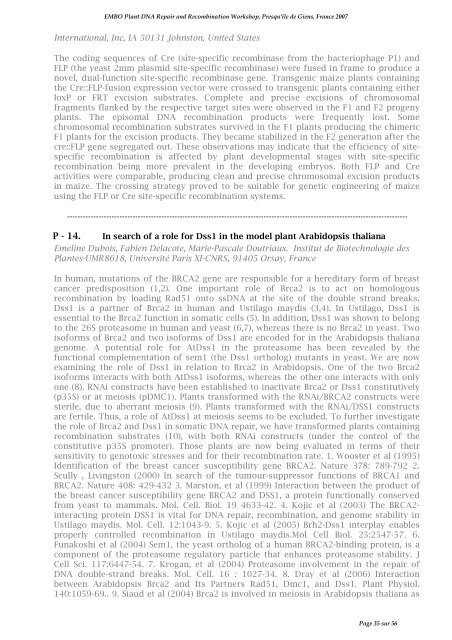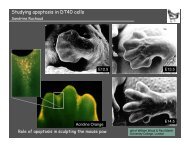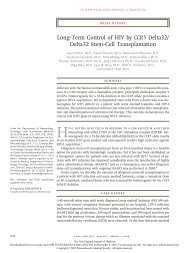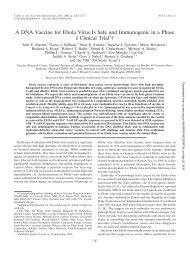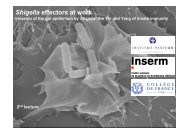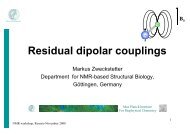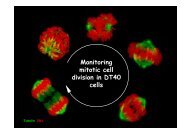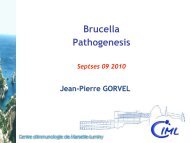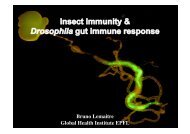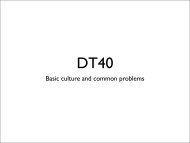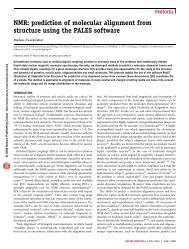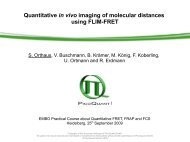pdf file - Events - EMBO
pdf file - Events - EMBO
pdf file - Events - EMBO
You also want an ePaper? Increase the reach of your titles
YUMPU automatically turns print PDFs into web optimized ePapers that Google loves.
<strong>EMBO</strong> Plant DNA Repair and Recombination Workshop, Presqu'île de Giens, France 2007<br />
International, Inc, IA 50131 Johnston, United States<br />
The coding sequences of Cre (site-specific recombinase from the bacteriophage P1) and<br />
FLP (the yeast 2mm plasmid site-specific recombinase) were fused in frame to produce a<br />
novel, dual-function site-specific recombinase gene. Transgenic maize plants containing<br />
the Cre::FLP-fusion expression vector were crossed to transgenic plants containing either<br />
loxP or FRT excision substrates. Complete and precise excisions of chromosomal<br />
fragments flanked by the respective target sites were observed in the F1 and F2 progeny<br />
plants. The episomal DNA recombination products were frequently lost. Some<br />
chromosomal recombination substrates survived in the F1 plants producing the chimeric<br />
F1 plants for the excision products. They became stabilized in the F2 generation after the<br />
cre::FLP gene segregated out. These observations may indicate that the efficiency of sitespecific<br />
recombination is affected by plant developmental stages with site-specific<br />
recombination being more prevalent in the developing embryos. Both FLP and Cre<br />
activities were comparable, producing clean and precise chromosomal excision products<br />
in maize. The crossing strategy proved to be suitable for genetic engineering of maize<br />
using the FLP or Cre site-specific recombination systems.<br />
----------------------------------------------------------------------------------------------------------------------------------<br />
P - 14. In search of a role for Dss1 in the model plant Arabidopsis thaliana<br />
Emeline Dubois, Fabien Delacote, Marie-Pascale Doutriaux. Institut de Biotechnologie des<br />
Plantes-UMR8618, Université Paris XI-CNRS, 91405 Orsay, France<br />
In human, mutations of the BRCA2 gene are responsible for a hereditary form of breast<br />
cancer predisposition (1,2). One important role of Brca2 is to act on homologous<br />
recombination by loading Rad51 onto ssDNA at the site of the double strand breaks.<br />
Dss1 is a partner of Brca2 in human and Ustilago maydis (3,4). In Ustilago, Dss1 is<br />
essential to the Brca2 function in somatic cells (5). In addition, Dss1 was shown to belong<br />
to the 26S proteasome in human and yeast (6,7), whereas there is no Brca2 in yeast. Two<br />
isoforms of Brca2 and two isoforms of Dss1 are encoded for in the Arabidopsis thaliana<br />
genome. A potential role for AtDss1 in the proteasome has been revealed by the<br />
functional complementation of sem1 (the Dss1 ortholog) mutants in yeast. We are now<br />
examining the role of Dss1 in relation to Brca2 in Arabidopsis. One of the two Brca2<br />
isoforms interacts with both AtDss1 isoforms, whereas the other one interacts with only<br />
one (8). RNAi constructs have been established to inactivate Brca2 or Dss1 constitutively<br />
(p35S) or at meiosis (pDMC1). Plants transformed with the RNAi/BRCA2 constructs were<br />
sterile, due to aberrant meiosis (9). Plants transformed with the RNAi/DSS1 constructs<br />
are fertile. Thus, a role of AtDss1 at meiosis seems to be excluded. To further investigate<br />
the role of Brca2 and Dss1 in somatic DNA repair, we have transformed plants containing<br />
recombination substrates (10), with both RNAi constructs (under the control of the<br />
constitutive p35S promoter). Those plants are now being evaluated in terms of their<br />
sensitivity to genotoxic stresses and for their recombination rate. 1. Wooster et al (1995)<br />
Identification of the breast cancer susceptibility gene BRCA2. Nature 378: 789-792 2.<br />
Scully , Livingston (2000) In search of the tumour-suppressor functions of BRCA1 and<br />
BRCA2. Nature 408: 429-432 3. Marston, et al (1999) Interaction between the product of<br />
the breast cancer susceptibility gene BRCA2 and DSS1, a protein functionally conserved<br />
from yeast to mammals. Mol. Cell. Biol. 19 4633-42. 4. Kojic et al (2003) The BRCA2interacting<br />
protein DSS1 is vital for DNA repair, recombination, and genome stability in<br />
Ustilago maydis. Mol. Cell. 12:1043-9. 5. Kojic et al (2005) Brh2-Dss1 interplay enables<br />
properly controlled recombination in Ustilago maydis.Mol Cell Biol. 25:2547-57. 6.<br />
Funakoshi et al (2004) Sem1, the yeast ortholog of a human BRCA2-binding protein, is a<br />
component of the proteasome regulatory particle that enhances proteasome stability. J<br />
Cell Sci. 117:6447-54. 7. Krogan, et al (2004) Proteasome involvement in the repair of<br />
DNA double-strand breaks. Mol. Cell. 16 : 1027-34. 8. Dray et al (2006) Interaction<br />
between Arabidopsis Brca2 and Its Partners Rad51, Dmc1, and Dss1. Plant Physiol.<br />
140:1059-69.. 9. Siaud et al (2004) Brca2 is involved in meiosis in Arabidopsis thaliana as<br />
Page 35 sur 56


